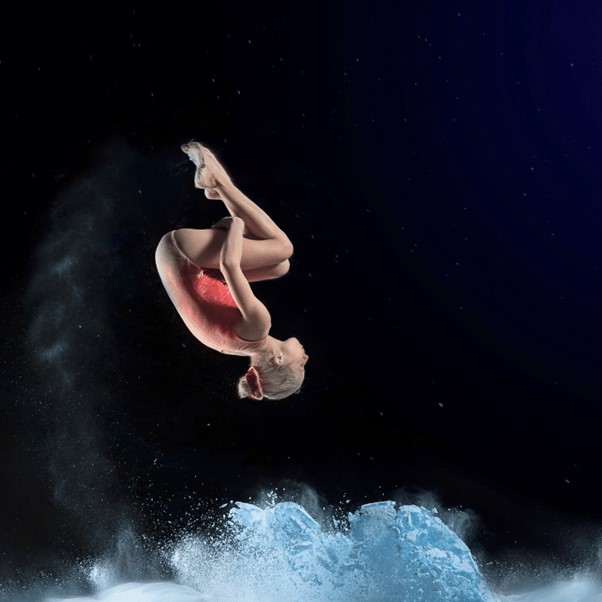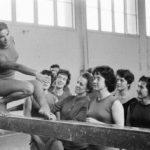
The types of somersaults in gymnastics are as varied and thrilling as the gymnasts performing them. From the classic forward salto to the intricate twists of the Tsukahara, this guide’s got the lowdown on every variation and combination you need to know.
Disclaimer: The information contained in this article does not replace the need for professional coaching or spotting in a recognized facility. Somersaults are dangerous when performed incorrectly.
Introduction
Gymnastics has always been known for its awe-inspiring moves, and somersaults are no exception. Whether you’re a gymnast yourself or a parent of one, or simply an admirer of the sport, understanding what a somersault is can deepen your appreciation for the skills required to perform such moves.
What is a Somersault in Gymnastics?
A somersault, in simple terms, is a skill that involves rotating the body while airborne. It is a fundamental movement in gymnastics, requiring the gymnast to jump into the air and execute a complete rotation before landing on the ground or another apparatus. Somersaults are often performed on floor exercises, balance beam, vault, and when dismounting from bars.
During a somersault the body rotates without touching the floor or apparatus which makes it different to a Back Handspring as the hands touch the floor.
When performing a somersault from the apparatus a gymnast will use the contact from the equipment to generate lift and rotation in much the same way that a gymnast on the floor will use the bounce generated through the sprung floor. Then, after releasing their hands from the apparatus, the gymnast will perform a somersault in the air before landing on their feet.
Types of Somersaults
Somersaults can be classified into different categories based on their take-off direction, body shape and whether there is a twist. Multiple somersaults also create further combinations. Let’s explore some of the most common types of somersaults:
Front Somersaults
Front somersaults are performed by taking off facing forward and rotating forward. This involves taking off facing forwards into the air and rotating the body in a forward direction, typically landing on the feet at the end. If you are familiar with forward roll on the floor, the front somersault is the same thing but in the air! Examples of front somersaults include front tucks, front pikes, and front layouts.
Back Somersaults
Back somersaults, as the name suggests, involve rotating backward. These skills require the gymnast to take off facing backward and then rotate the hips up and over the head. Imagine performing a backward roll in the air and you pretty much have a Back Somersault. The shape can vary in the same way that a front somersault does for example tucked, picked or layout (straight).
Many gymnasts find it harder to back salto than front salto because they cannot see the floor behind them when they take off.
Side Somersaults
Side somersaults are executed by rotating sideways. This type of salto requires the gymnast to half turn their body to the side during or just after take off. Side aerials and side somersaults are examples of side saltos.

Somersault Variations
Within the main types of somersaults, there are variations that gymnasts can perform to add complexity and artistry to their routines. In order of difficulty, starting with the easiest:
- Tuck Somersault: A salto executed with a tucked body position, where the gymnast brings their knees towards their chest to create a compact rotation.
- Pike Somersault: A salto performed with a piked body position, where the gymnast keeps their legs extended and bends at the hips/waist.
- Puck Somersault: An open tuck shape is sometimes used as a progression for learning the layout. The knees are still bent like a tuck but not brought into the chest. A puck salto is not usually used in competition.
- Layout Somersault: A salto executed with a straight body position and extended legs, creating a dynamic and visually appealing rotation. Although labeled a ‘straight’ salto, there is often some arching or hollow dishing of the body.
- Twisting Somersault: Saltos can incorporate twisting movements in addition to the rotational element. Twisting is usually performed in a layout shape.
- Double Somersaults: Two or more saltos can be performed in one go. Doubles, triples and quads have been performed by Power Tumblers and Trampoline gymnasts but anything above a double is very in artistic floor exercises.
Common Mistakes in Performing Somersaults
While somersaultss can be impressive and beautiful when executed correctly, they can also be challenging to master. Here are some common mistakes that gymnasts may encounter when performing somersaults:
- Lack of Height: One of the key aspects of a successful somersaults is generating enough height to complete the rotation. Insufficient height can lead to incomplete rotations or awkward landings.
- Poor Form: Maintaining proper form throughout the somersault is crucial for a clean and controlled rotation. Gymnasts should focus on keeping their body tight, maintaining a straight or appropriately positioned body shape based on the somersault type, and avoiding any excessive arching or rounding of the back.
- Under-Rotation or Over-Rotation: Finding the right amount of rotation can be challenging. Under-rotating a somersault can result in landing short, while over-rotating can lead to instability and difficulty in sticking the landing.
- Lack of Spotting: Spotting is an essential technique in gymnastics that involves identifying a specific point to focus on during the somersault. Not spotting or losing sight of the spot can affect balance and spatial awareness during the rotation.
- Insufficient Air Awareness: Air awareness refers to the ability to understand and control body movements while in the air. Lack of air awareness can make it difficult to execute the somersault precisely and can result in awkward landings or falls.

How to Improve Somersault Technique
Improving your somersault technique requires practice, focus, and attention to detail. Here are some tips to enhance somersault execution:
- Develop Strength and Flexibility: Building core strength and flexibility is essential for executing powerful and controlled somersaults. Incorporate conditioning exercises and stretches into your training routine to enhance your physical capabilities.
- Work on Proper Takeoff and Entry: A strong and precise takeoff is vital for generating height and momentum in your somersault. Focus on explosive leg drive, maintaining a tight body position, and engaging your core during the takeoff.
- Master Body Control: Learning to control your body throughout the somersault is crucial. Practice body shaping drills, such as hollow body holds and tuck jumps, to improve your body control and awareness during rotations.
- Gradual Progression: Start with simpler somersault and gradually progress to more complex variations. It’s important to build a solid foundation of technique and confidence before attempting more challenging skills.
- Seek Professional Coaching: Working with a qualified gymnastics coach can provide valuable guidance and feedback on your technique. They can help identify areas for improvement, provide drills and exercises tailored to your needs, and ensure safety during training.
Gymnasts often learn how to somersault using a Trampoline or other types of rebound equipment because they generate way more height and allow the gymnast to focus on technique and shaping.
However, the additional height from a Trampoline also increases the risk of injury when performing somersaults. Professional gymnasts have spotters at the side of the trampoline to throw in mats if it looks like they will land badly.
Safety Considerations for Somersaults
While different types of somersaults can be exhilarating, safety should always be a top priority. Here are some safety considerations to keep in mind when practicing somersaults:
- Proper Equipment: Ensure that you are using appropriate and well-maintained equipment, such as landing mats and spotting belts, to minimize the risk of injuries.
- Warm-up and Stretching: Always warm up your body and perform stretching exercises before attempting somersaults. This helps prevent muscle strains and prepares your body for the demands of the skill.
- Spotting and Progression: Work with a qualified spotter or coach when learning and practicing somersaults. They can provide support, guidance, and ensure a safe environment for skill development.
- Controlled Environment: Perform somersaults in a suitable training area that provides ample space and is free of hazards. Avoid practicing on hard or uneven surfaces.
- Listen to Your Body: If you experience pain or discomfort during training, listen to your body and seek appropriate medical attention if needed. Pushing through injuries can lead to further harm.
Conclusion
Somersaults are captivating and dynamic moves in gymnastics that showcase the incredible skill and athleticism of gymnasts. Understanding the concept of a somersault, its various types and variations, common mistakes to avoid, and techniques to improve your performance can elevate your appreciation for this impressive skill.
By focusing on proper technique, body control, and gradual progression, gymnasts can enhance their ability to execute somersaults effectively. However, it is crucial to prioritize safety throughout the learning process. Utilizing appropriate equipment, warming up properly, seeking professional coaching, and practicing in controlled environments are essential steps to minimize the risk of injuries.
In conclusion, the different types of somersaults are a fundamental aspect of gymnastics, adding flair and excitement to routines. By mastering the techniques, incorporating variations, and ensuring safety, gymnasts can showcase their prowess and captivate audiences with their remarkable somersault skills.
Interested in learning how to somersault? Try a free trial in one of our classes and take your first step in learning the the right way!
FAQs (Frequently Asked Questions)
Are somersaults only performed by advanced gymnasts?
Different types of Somersaults can be performed by gymnasts at intermediate to advanced level. Beginners may start with simpler progressions and gradually move on to attempting tucked somersaults as they develop their technique and strength. Beginners would need to be familiar with basic gymnastics shapes and have a spotter at all times.
How long does it take to learn a somersault?
The time it takes to learn a somersault varies depending on individual factors such as athleticism, training frequency, and dedication. It can range from several months to years of consistent practice.
Can somersaults be performed on all gymnastics apparatus?
Somersaults can be performed on various apparatus in gymnastics, including floor exercise, balance beam, vault, and uneven bars. However, the technique and execution may differ slightly based on the specific apparatus.
What should I do if I’m afraid of performing somersaults?
Fear is natural when attempting new and challenging skills. Working with a supportive coach, gradually building confidence through progressions, and focusing on proper technique can help overcome fear.
If you are still really worried – don’t attempt to do a somersault. Focus on more basic moves such as forward rolls, backward rolls and handstands.
Can somersaults be incorporated into other sports or fitness activities?
While somersaults are commonly associated with gymnastics, different types of somersaults can also be found in activities like free running, trampoline, diving, and acrobatics. It is important to receive proper training and guidance when attempting somersaults in any context outside of gymnastics.
- A Complete Guide to Gymnastics Hand RipsAre you tired of dealing with painful gymnastics rips on your hands from training? Look no further – this article offers a comprehensive approach to… Read more: A Complete Guide to Gymnastics Hand Rips
- Is Gymnastics Dangerous? (Facts and Comparisons)Gymnastics is acknowledged as a highly technical and physically demanding sport. It inherently carries a risk of injury, which is why most coaches and clubs… Read more: Is Gymnastics Dangerous? (Facts and Comparisons)
- The Fascinating Evolution of Gymnastics (History and Facts)Gymnastics is a sport that has been around for centuries and has evolved significantly throughout history. From its origins in ancient Greece to the modern-day… Read more: The Fascinating Evolution of Gymnastics (History and Facts)
- The Ultimate Parallel Bars Skills ListParallel bars are one of the most challenging events in men’s gymnastics. Mastering the right moves first on parallel bars is essential to improving your… Read more: The Ultimate Parallel Bars Skills List
- The Long-Term Effects of Gymnastics on the Body (A Complete Guide)While gymnastics can offer many benefits, such as improved fitness and self-confidence, many people also ask what are the Long-Term Effects of Gymnastics on the… Read more: The Long-Term Effects of Gymnastics on the Body (A Complete Guide)
- What Age Does Competitive Gymnastics Start?Ever wondered what age does competitive gymnastics start? It’s well known that gymnasts start training at a young age to develop the skills and strength… Read more: What Age Does Competitive Gymnastics Start?






